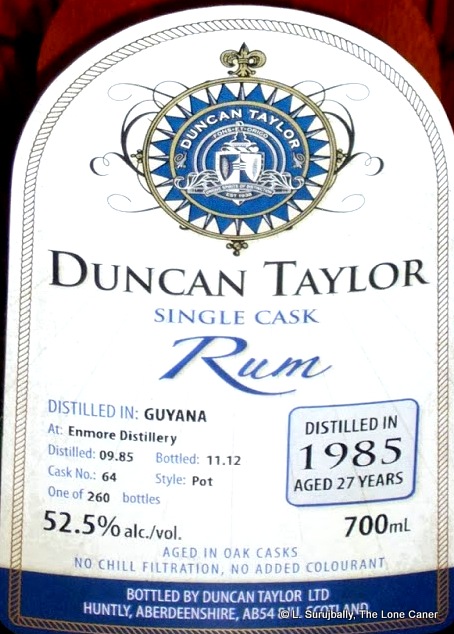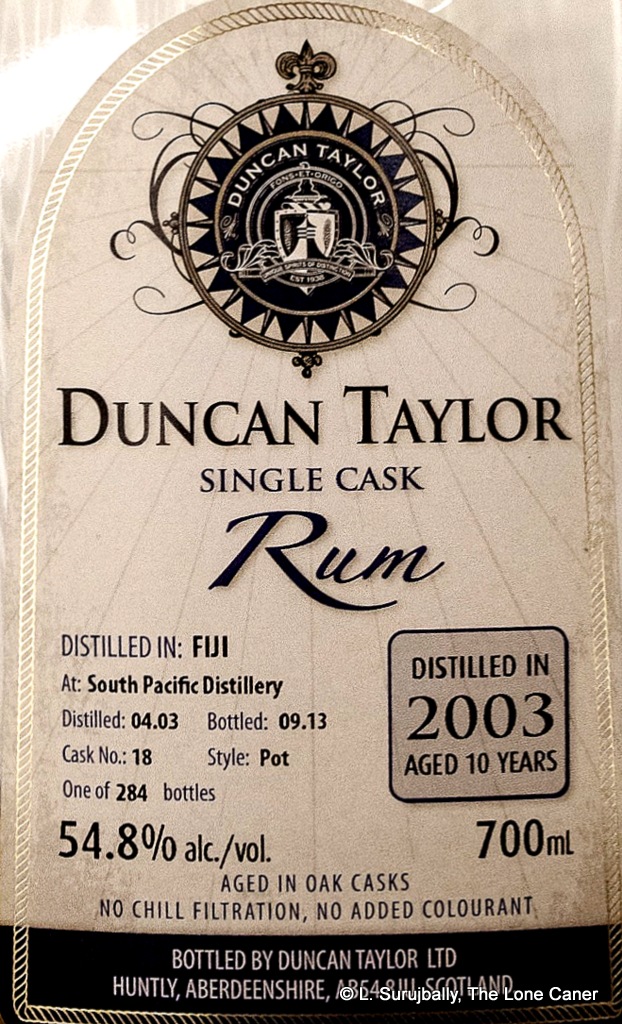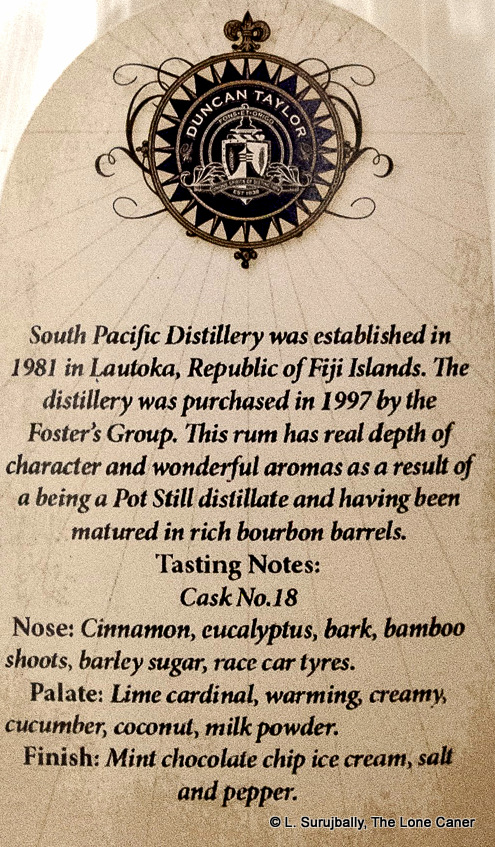
#515
Two independent bottlers out of Europe which I have not done much with are Mezan and Duncan Taylor, though I have samples and a plethora of notes of rums from both. Let’s try to remedy that this week with a quick look at the current subject, which presses many of my buttons at once: it’s from Enmore estate but the single wooden Versailles pot still (which alongside Port Mourant is one of my favourite stills from Guyana), distilled in 1985 and bottled in 2012 so a hefty 27 years old, and it has a no-nonsense strength of 52.5%. Need I say continental ageing? No additives or messing around? Probably not. You could tell that as one of the first rums they issued, they probably figured that they’d release a 27 year old Hulk to the market and reap all the glory therefrom.
Did they succeed? Not quite.The nose was fine, mind – very light, thin and sharp, redolent of glue, acetones, pencil shavings, the rich aroma of a brand new leather jacket, oak, a little anise and a raft of light and indeterminate fruits (apples, orange peel and pears) that were difficult to pick apart. It had a musty sort of smell too…like aged, dust-covered old books in a stuffy library. Odd, but by no means unpleasant.
 Thinness of the nose aside, the palate took something of a ninety degree left turn. It felt thicker, richer, with the glue and furniture polish notes receding, yet what emerged was a rum that seemed over-oaked, and very dry, very crisp. What fruits there were – and there were some, mostly raisins, pears, unripe apples and green mangoes – were of the mouth puckering kind, quite tart, accompanied by orange peel, nutmeg, cardboard or drywall, and something that reminded me of the dustiness of a drought-stricken backyard. The strength was fine for what it was – not low enough to make it a mild crowd-pleaser, not so strong as to make it an assault on the tongue, so on that level it succeeded just fine. The finish gave up more of those tart fruity sensations, oak notes, some pepper and cooking herbs (thyme and parsley)…yet overall, it somehow failed to cohere really well, and the whole experience was deflated by its relative lack of voluptuousness that either some more ageing or some time in tropical climes might have ameliorated.
Thinness of the nose aside, the palate took something of a ninety degree left turn. It felt thicker, richer, with the glue and furniture polish notes receding, yet what emerged was a rum that seemed over-oaked, and very dry, very crisp. What fruits there were – and there were some, mostly raisins, pears, unripe apples and green mangoes – were of the mouth puckering kind, quite tart, accompanied by orange peel, nutmeg, cardboard or drywall, and something that reminded me of the dustiness of a drought-stricken backyard. The strength was fine for what it was – not low enough to make it a mild crowd-pleaser, not so strong as to make it an assault on the tongue, so on that level it succeeded just fine. The finish gave up more of those tart fruity sensations, oak notes, some pepper and cooking herbs (thyme and parsley)…yet overall, it somehow failed to cohere really well, and the whole experience was deflated by its relative lack of voluptuousness that either some more ageing or some time in tropical climes might have ameliorated.
Duncan Taylor started life in 1938, formed by Abe Rosenberg and his two brothers, who had a sales license for major states in the US which allowed for rapid growth in the post-war years (especially with the J&B brand). It was a company that dealt in whiskies, both as a merchant and as a broker in Glasgow, and over time they acquired what was one of the largest privately-held collections of rare malt whisky casks in the world. The partnership was sold in 1980, but the collection of whiskies owned by Duncan Taylor was not part of that sale. Euan Shand and his partner Alan Gordon bought it in 2002 and moved the company to Scotland. At that point they made a conscious decision to cease operating as a broker and tread down the road of being an indie bottler of their own branded whiskies. In 2012 they expanded the portfolio into rums as well, although thus far it seems that those who have been fortunate enough to review some of their work (mostly Wes and Steve), feel that it’s a bit hit or miss.
Here, I’d have to say that the Enmore 27 YO is rather more miss than hit, and it copied the form of the Veliers without the underlying passion that served Luca so well in his own Enmores and Versailles rums. Which is surprising because even in continental climes, twenty seven years is twenty seven years and I somehow felt there should be more on display here. But it just doesn’t gel for me – there’s a thin kind of hardness to the experience which I did not like, a sort of cold, austere, uncompromising lack of warmer flourishes and tastes which I see in tropically aged rums that slept many years less. Essentially, it tastes like it’s not quite ready to be decanted, and in summary, I conclude by noting that Duncan Taylor might have thought, when they issued this well-aged rum, that they were channelling the Hulk…but in reality, after all that time, only succeeded in growing a green fingernail.
(84/100)
Other notes
Thanks and a hat-tip to Maco Freyr of Barrel Aged Mind, who not only wrote the definitive biography of the company, but sent me the sample…which he also reviewed, more positively than I did. He also wrote that the rum was not from the Enmore wooden coffey still, but the Versailles single wooden pot still which was housed at Enmore before being moved to Diamond. The word “pot” on the bottle label makes that clear, hence the title of the post


